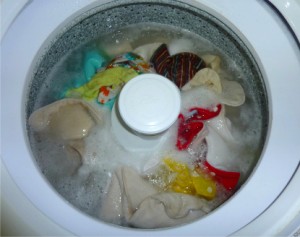While regular laundry likely does not ever need stripping or deep washing, cloth diapers are a bit different as there can be build up from diaper rash creams, powders, and fabric softeners that cause the fabric to no longer work well as a diaper. Let’s talk about stripping.
Strip.
From Merriam-Webster: to remove extraneous or superficial matter from <a prose style stripped to the bones>
Stripping diapers. What? Why strip?
Let’s face it. Every now and then, despite our best efforts, our cloth diapers can get a little funky. It comes with the territory. When the cloth starts to groove with the funk, it is time for a tweak in the washing routine or a strip. Or just a re-wash for that time your mother-in-law thought she was doing you a favor.
Some of the more obvious reasons for your diapers bringing on the funk are:
- Repelling due to odd detergent build up.
- Ammonia build up from not getting clean enough.
- Residue or repelling from a fabric softener or diaper rash cream.
- Dawn original dish soap. It strips grease and cuts through build up. Why dawn? It is super concentrated and sticking to one concentrated form keeps it consistent. I have tried other dish washing liquids though. However, I didn’t have repelling build up and cannot say if the other brands or types work as well for removing oily residue. Add just a couple drops of Dawn (really just a couple drops, no more) to your washing machine after your have cleaned your diapers. Add the diapers and let the machine run a cycle. Continue running rinse cycles until you see no suds. If you have an obvious visual residue from a cream, you can apply Dawn to the area and brush it lightly with a tooth brush.
- Boiling. You can boil prefolds, flats and inserts to strip. Boiling can release residue and kill bacteria. Do not boil anything with snaps, elastic, or PUL or TPU. Covers and pocket shells should not be boiled. Obviously wash the cloth diapers first, and then boil them for 15 minutes in a large kettle. If suds occur, you may need to empty the pot and refill. The intense heat is usually enough to remove impurities.
- Bleach. Sometimes bacteria and ammonia happen despite our best intentions or washing routine. Hard water and/or an HE washing machine can be the culprits. Bleach can be used to strip inserts or it can be used occasionally as a maintenance measure against stink issues. Check with your manufacturer. Bumgenius recommends bleaching once a month, but for some brands it will void your warranty.
- RLR. RLR Laundry Treatment is an unofficial stripper for cloth diapers. It removes minerals from hard water along with detergent build up. It is great for dingy bath towels. It gets whites whiter and colors bright by getting out the funk. If you have hard water you might be getting mineral build up on your diapers causing stink and less absorbency. RLR can be used to clean your washing machine and strip your diaper inserts. Check with your manufacturer first. It is best to use it on the prefolds and inserts but not covers and pocket shells.
- Vinegar. Vinegar can be used as a rinse aide. The acidic nature of vinegar helps rinse out access sodium percarbonate which is a water softener and laundry aide. The harder your water, the more sodium percarbobate (washing soda or soda ash) you need to have in your washing routine. Soda ash is very basic so the acidic vinegar can help neutralize and rinse it out. This may involve some trial and error to see if it helps and in what amounts for your water hardness and washing routine.
Back to detergents.
Some people find the more natural or “green” detergents determined cloth diaper friendly to not have enough cleaning power. This can warrant the use of more intensive detergents like Tide or Gain. If you use a more hardcore detergent make sure to use the powder and not liquid. Liquid detergent is harder to rinse out and can cause significant issues. One thing some people run into is the intensive commercial detergent gets the ammonia out of diapers, but then they have a hard time getting the detergent out of the diapers. This is where “stripping” can consist of just a few washes without any detergent at all. I have heard of people using tide to wash out the ammonia funk and then using a natural detergent to wash out the Tide. I admit I gave this type of routine a try recently. I actually added Arm&Hammer powder to my pre-wash. Then for the regular wash, I used my normal mild detergent to get out the Arm&Hammer. I did have to add an extra rinse to my routine, but overall, it has been very effective. No soaking required and no funk out of the dryer causing me to wash them all over again. If this idea is unappealing to you I would suggest picking up some washing soda. Washing soda softens water and pulls grime from fabric. Adding a dash to your pre-wash may be all you need to solve some issues.
The point is that cloth diaper washing and stripping is mostly trial and error. Usually stripping isn’t necessary. Stink and buildup can normally be resolved by a proper washing routine. It just takes quite a few tries (many, many for hard water or HE machines) for some to figure out the right routine for their circumstances.


